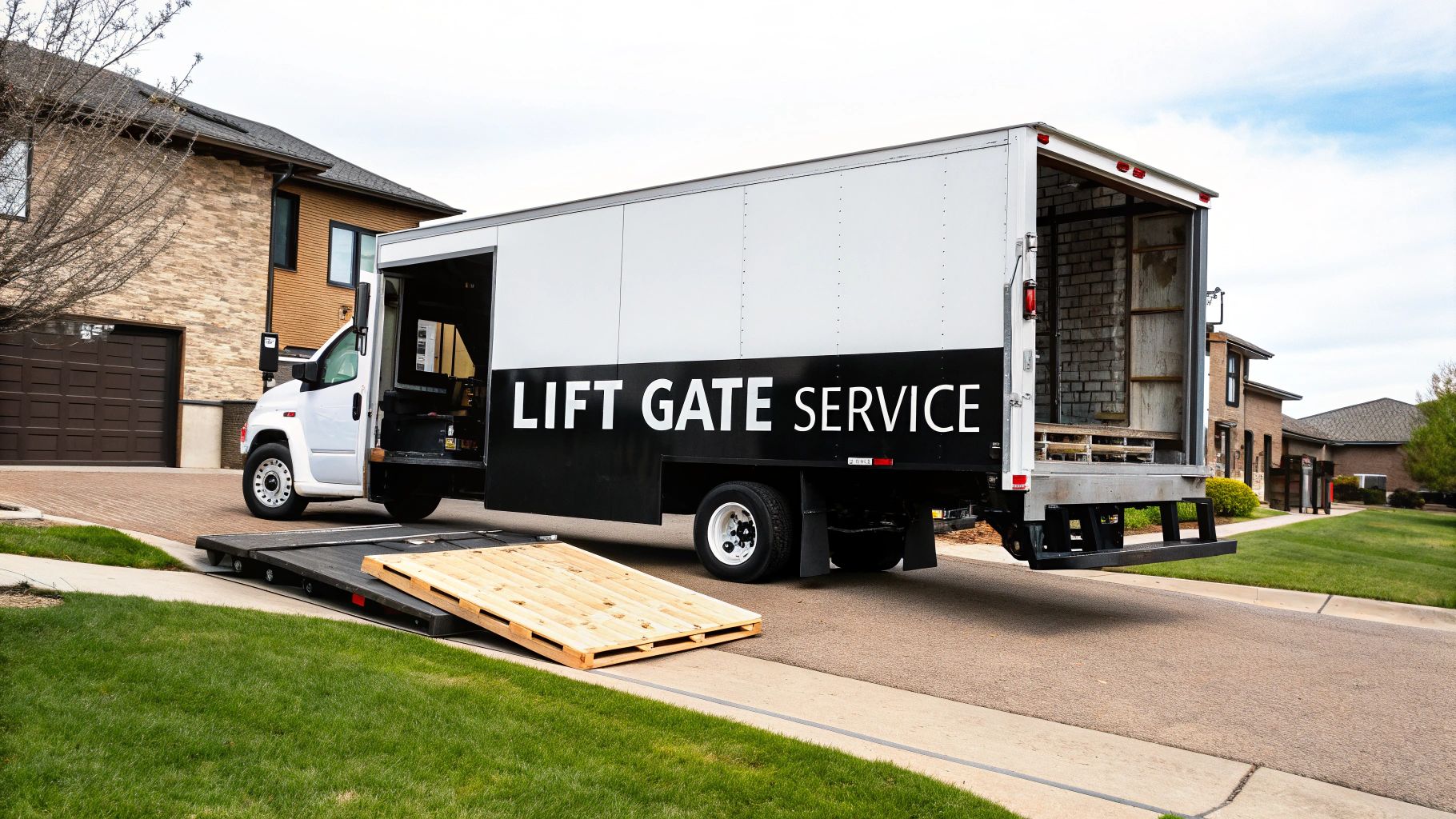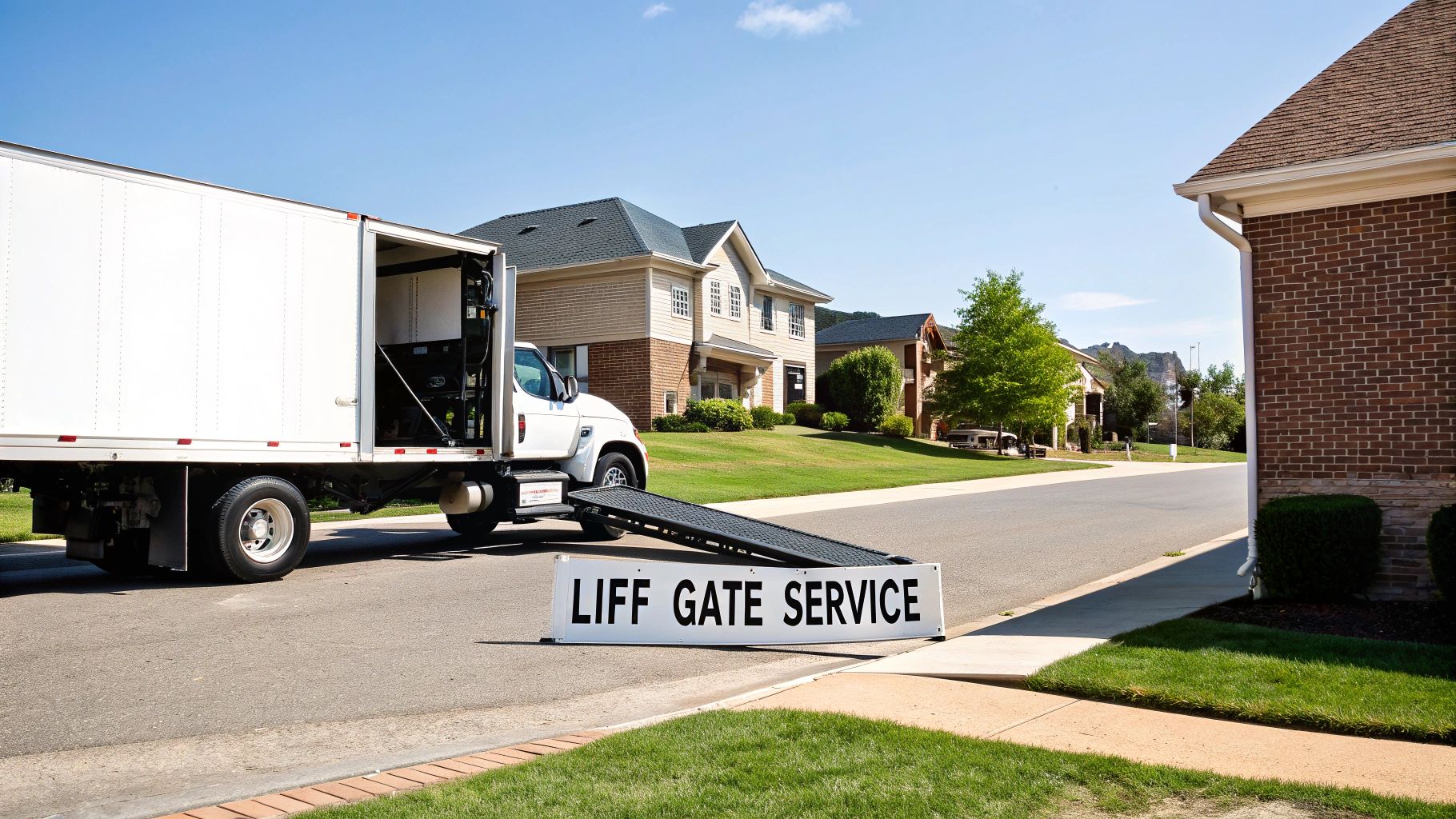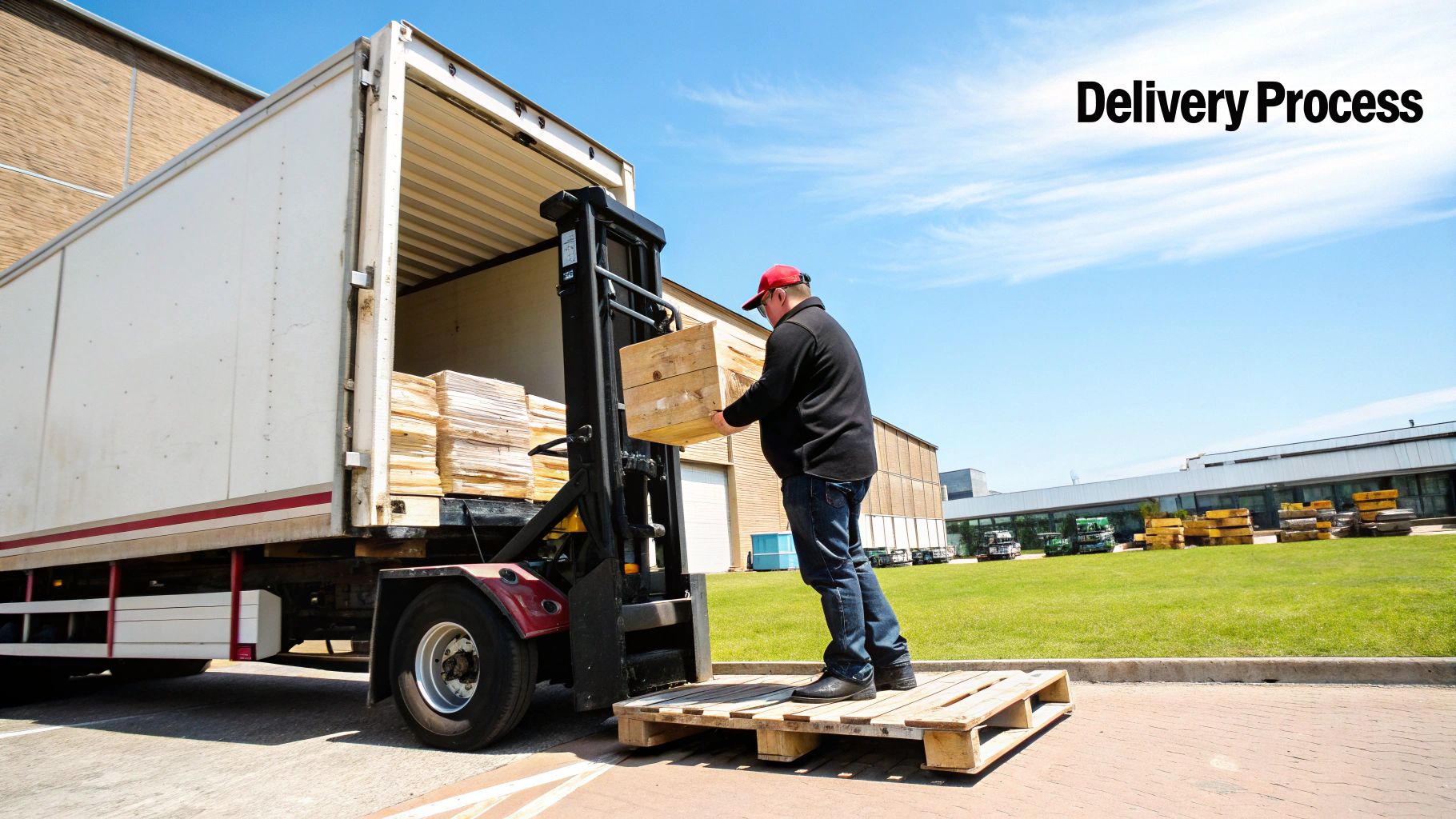What is lift gate service? Learn how it works, when to use it, and how it makes shipping heavy freight safer and easier for your business or home delivery.

Ever found yourself staring at the back of a delivery truck, wondering how on earth you're going to get that massive pallet to the ground? That's where lift gate service comes in.
Think of it as a personal elevator for your freight. It's a hydraulic platform attached to the back of the truck that smoothly lowers heavy items from the truck bed right down to street level. This simple but brilliant mechanism is a game-changer for anyone shipping to a location without a dedicated loading dock or a forklift on hand.
Picture this: your new commercial oven or that beautiful oak dining set you ordered arrives. The truck pulls up, and the floor of the trailer is about four feet off the ground. Getting that item down isn't just tricky; it's dangerous.

Without a lift gate, you’re looking at a serious risk of damaging your shipment or, even worse, causing an injury. Nobody wants to try and manhandle a 500-pound crate off the back of a truck. The lift gate service bridges that crucial gap between the truck and the curb, making what would be a logistical nightmare a simple, safe, and routine process.
It’s an absolute must for deliveries to places like residential homes, construction sites, or small businesses in a strip mall that lack proper receiving facilities.
Curious what a lift gate will add to your LTL or FTL shipment? Get a free, instant freight quote to find out.
Figuring out if you need a lift gate is pretty simple. Just ask yourself: does the pickup or delivery location have a loading dock or a forklift? If the answer is no, you almost certainly need to request a lift gate.
This becomes especially true for any single item weighing over 150 pounds. At that point, trying to lift it by hand is just asking for trouble.
A lift gate isn't just a nice-to-have feature; it’s a critical tool for safety and accessibility. Booking it from the start saves you from the headache of a failed delivery, extra fees, and potential damage to your goods.
Still not sure? This quick guide should clear things up.
Use this quick reference to determine if your shipment requires a lift gate at pickup or delivery.
Essentially, if you’re shipping from or to any place that isn't a dedicated commercial facility designed for freight, adding a lift gate is the smart move.
So, what really happens when that big truck with your shipment pulls up? Let's walk through the process from start to finish.
First things first, the driver finds a safe, flat spot to park. They need enough room to operate the lift gate without any obstacles, so positioning the truck correctly is the crucial first step for a smooth unload.

With the truck in place, the driver grabs a remote control and activates the lift gate. You'll see a metal platform unfold from the back of the truck, essentially becoming a mini-elevator for your freight. These drivers are pros, trained to handle this powerful machinery safely and efficiently.
Watching it happen is pretty straightforward, but it's a carefully choreographed set of actions. The driver will use a pallet jack to roll your shipment from inside the truck right onto the lift gate platform.
Heads up: Standard lift gate service gets the freight from the truck to the ground. The driver’s job usually ends at the curb. Moving the item inside your home or business is considered a different service altogether.
This seamless process is a critical part of what makes the final delivery successful. If you're curious about how this fits into the broader logistics world, you can learn more in our guide to last-mile delivery optimization.
Ultimately, a lift gate isn't just a piece of equipment; it’s a professional service designed for safety and convenience. Knowing how it works helps you know what to expect, ensuring your delivery day is totally hassle-free.
Deciding to use a lift gate is more than just a simple add-on; it's one of the smartest moves you can make to protect your shipment, your wallet, and even your back. The benefits really boil down to three key areas that make it an essential tool in modern shipping.
First up, and most importantly, is safety. Let's be honest, trying to wrestle a heavy, awkward item off a truck bed that’s four feet off the ground is asking for trouble. A lift gate takes that risk right out of the equation. It dramatically cuts down on the chances of someone getting hurt or your expensive freight getting damaged on its way to the ground.
Then there's the huge advantage of accessibility. If you don’t have a lift gate, you're pretty much stuck shipping only to places with a proper loading dock. This service blows the doors wide open, making it possible to deliver to almost anywhere—a residential home, a small storefront, a school, or even a construction site. It makes freight shipping possible for everyone, not just big commercial operations.
Thinking about taking your delivery to the next level? If you need more than just getting the item to the curb, you might want to see how this compares to a more premium option. We break it all down in our guide on what is white glove delivery service.
Finally, you just can't beat the sheer convenience. Think about the alternative for a minute. You'd have to scramble to rent a forklift for a single delivery or try to rally enough people to help you unload. A lift gate gets rid of all that chaos. It's a huge time-saver and prevents a major headache.
For example, a new restaurant getting a commercial oven delivered or a homeowner receiving a large treadmill can just let the lift gate do the work. It turns what could be a massive logistical nightmare into a smooth, professional process.
This convenience has become absolutely vital with the boom in e-commerce. As more people buy bulky items online, the need for residential deliveries—where loading docks are nonexistent—has skyrocketed. Lift gates are the unsung heroes of this shift. In fact, some studies show they can slash manual lifting injuries by as much as 90%. That’s a game-changer.
Ready to see how affordable and convenient your next FTL or LTL freight shipment can be?
So, how do you know if you actually need to tack on lift gate service for your shipment? It’s a great question, because guessing can lead to some nasty surprises, like surprise fees and frustrating delays. The good news is, it's usually pretty easy to figure out.
The biggest giveaway is simple: what does the pickup or delivery spot look like? If there’s no loading dock or forklift in sight, you must add a lift gate. That one rule of thumb will steer you right most of the time.
Think about where the truck is actually going. Some places are practically guaranteed not to have the right setup for unloading a pallet straight off a trailer.
This is where a lift gate becomes a non-negotiable part of the delivery, ensuring everything happens safely and smoothly.
Beyond the location, the weight of your cargo is the other major factor. If any single item in your shipment is over 150 pounds, a lift gate is essential. That's really the safety limit for what one person can be expected to handle without risking injury or dropping your goods.
If you want to learn more about the different kinds of shipping, our LTL definition and logistics guide is a great place to start.
Still on the fence about whether you need it? It's always better to be safe than sorry. Don't guess and hope for the best—let an expert confirm it for you when you book your FTL or LTL shipment.
So, you're looking at your freight quote and see a line item for "lift gate service." It’s totally normal to ask, "What am I paying for here?" In the shipping world, this is what's known as an "accessorial fee"—basically, an add-on charge for a specific service beyond the standard point-A-to-point-B transport.
There are a few solid reasons carriers charge for this. That hydraulic lift on the back of the truck is a serious piece of equipment. It's expensive to install and requires constant, specialized maintenance to keep it working safely. The fee helps cover those costs, the extra time the driver spends on-site, and the increased liability the carrier takes on when moving heavy freight off their truck for you.
Even though it’s an extra charge, it's smarter to think of it as an investment in a hassle-free delivery. That predictable, flat fee is a bargain compared to the headaches you could face without it.
Imagine this: the truck arrives, and you suddenly realize you have no way to get your pallet off. Now you're in a bind. You might get slapped with a last-minute lift gate fee that's much higher than the one you would have booked ahead of time. Even worse, the driver might not be able to unload at all, leaving you with hefty redelivery fees and a major delay. And that doesn't even touch on the potential cost of damaged goods if you try to wrestle the shipment down yourself.
Paying for a lift gate isn't about convenience—it's about smart planning and managing risk. It turns a potential delivery nightmare into just another smooth step in the process.
It’s not just about avoiding problems, either. Some logistics providers have found that using a lift gate can speed up deliveries by as much as 30% and cut down on operational costs by 20% compared to unloading by hand. This kind of efficiency means businesses can send more kinds of products to more places, without getting bogged down by logistics. You can learn more about how lift gate adaptability is vital for modern supply chains.
Find out how much a lift gate adds to your LTL or full truckload shipment with a free, instant quote.
Getting your shipment delivered smoothly often comes down to dodging a few common, and surprisingly costly, mistakes. Knowing what these pitfalls are is your best defense against surprise fees and frustrating delays.
The single biggest error we see? Assuming a commercial location automatically has a loading dock. Just because it’s a business doesn’t mean it’s set up to handle freight trucks. You absolutely have to confirm with the recipient before you book anything.
Another classic oversight is forgetting that a lift gate might be needed on both ends of the trip. If your pickup spot doesn't have a dock and neither does the destination, you’ll need to request and pay for the service twice. It’s a simple detail that’s easy to miss.
To keep your freight moving without a hitch, be sure to watch out for these classic blunders:
A quick confirmation call upfront can save you from a major logistical headache. By avoiding these simple mistakes, you turn a potentially chaotic process into a predictable, stress-free delivery.
As deliveries to non-traditional locations have boomed, lift gates have become indispensable. A standard lift gate can typically handle 1300-1500 lbs, making it a fantastic tool for getting heavy goods on and off a truck safely. You can learn more about how liftgates became a crucial component of modern logistics.
Avoid the headaches and get an accurate FTL or LTL quote from the start.
When you're arranging a freight shipment, a few common questions about lift gates always seem to come up. Getting the right answers ahead of time is the key to making sure your delivery day goes smoothly. Let's clear up the confusion.
That’s a common misconception, but no, it doesn’t. Think of a lift gate as a small elevator on the back of the truck, designed for one specific job: lowering your freight from the trailer to the ground. That's it.
The driver’s responsibility ends once your pallet is safely on the curb or at the edge of your driveway. If you need someone to bring the item into your garage, home, or business, you'll need to ask for a separate service like "Inside Delivery" or "White Glove Service" when you book the shipment.
Most standard lift gates on LTL trucks are rated to handle a pretty wide range, typically somewhere between 1,500 and 3,000 pounds. But—and this is a big but—it’s not a universal standard. The capacity can vary from one carrier to another, and even between different trucks in the same company's fleet.
This is exactly why providing the accurate weight of your shipment is so critical when you get a quote. It allows the carrier to send a truck with the right equipment for the job. If your freight is heavier than their standard lift gate can manage, you’ll need to figure out an alternative solution before the truck shows up.
You can, but you really, really don't want to. Trying to add a lift gate after the freight is already on the road is a logistical nightmare that gets expensive fast. It usually means your shipment has to be rerouted to a terminal, unloaded, and then reloaded onto a different truck that has a lift gate.
This isn't just a simple switch. It causes major delays and racks up extra fees, like charges for rerouting and redelivery. These last-minute surprise costs are almost always way more expensive than just adding the lift gate fee from the start. Trust me, it’s best to get it right from the beginning.
Ready to book your next LTL or full truckload shipment with confidence? Get a free, instant freight quote now.